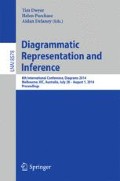Abstract
Despite our increasing reliance on diagrams as a form of communication there is little guidance for educators on how to teach students to think critically about diagrams in general. Consequently, while we teach students to read specific kinds of diagrams within specific contexts, we lack a coherent approach to thinking critically about diagramsper se. This paper presents a theoretical framework for a general diagrammatic literacy, based on conceptualizing diagrams in terms of function rather than form. Approaching diagrams functionally generates a framework for thinking critically about diagrams (in general) that is simple, robust and exhaustive. In addition to this functional approach, the role of context and language to the internal definition of any given diagram is emphasized.
Access this chapter
Tax calculation will be finalised at checkout
Purchases are for personal use only
Preview
Unable to display preview. Download preview PDF.
References
Novick, L.R.: The Importance of Both Diagrammatic Conventions and Domain-Specific Knowledge for Diagram Literacy in Science: The Hierarchy as an Illustrative Case. In: Barker-Plummer, D., Cox, R., Swoboda, N. (eds.) Diagrams 2006. LNCS (LNAI), vol. 4045, pp. 1–11. Springer, Heidelberg (2006)
Skaife, M., Rogers, Y.: External cognition, interactivity and graphical representations. In: Proceedings of the IEE Colloquium: Thinking with Diagrams, pp. 8/1–8/6 (1996)
Blackwell, A.: Introduction Thinking with Diagrams. In: Blackwell, A.F. (ed.) Thinking with Diagrams, pp. 1–3. Kluwer Academic Publishers (2001)
Elzer, S., Carberry, S., Demir, S.: Communicative Signals as the Key to Automated Understanding of Simple Bar Charts. In: Barker-Plummer, D., Cox, R., Swoboda, N. (eds.) Diagrams 2006. LNCS (LNAI), vol. 4045, pp. 25–39. Springer, Heidelberg (2006)
Acarturk, C., Habel, C., Cagiltay, K.: Multimodal Comprehension of Graphics with Textual Annotations: The Role of Graphical Means Relating Annotations and Graph Lines. In: Stapleton, G., Howse, J., Lee, J. (eds.) Diagrams 2008. LNCS (LNAI), vol. 5223, pp. 335–343. Springer, Heidelberg (2008)
Feeney, A., Hola, A.K.W., Liversedge, S.P., Findlay, J.M., Metcalf, R.: How People Extract Information from Graphs: Evidence from a Sentence-Graph Verification Paradigm. In: Anderson, M., Cheng, P., Haarslev, V. (eds.) Diagrams 2000. LNCS (LNAI), vol. 1889, pp. 149–161. Springer, Heidelberg (2000)
Stenning, K.: Distinctions with Differences: Comparing Criteria for Distinguishing Diagrammatic from Sentential Systems. In: Anderson, M., Cheng, P., Haarslev, V. (eds.) Diagrams 2000. LNCS (LNAI), vol. 1889, pp. 132–148. Springer, Heidelberg (2000)
Conrad, J.: Letter to HG Wells, 19/09/1903. In: Karl, F., Davies, L. (eds.) The Collected Letters of Joseph Conrad, p. 62. Cambridge University Press (1988)
Larkin, J.H., Simon, H.A.: Why a diagram is (sometimes) worth ten thousand words. Cognitive Science 11, 65–100 (1987)
Nightingale, F.: Diagram of the causes of mortality in the army in the East. Notes on Matters Affecting the Health, Efficiency and Hospital Administration of the British Army. Harrison and Sons (1858)
Niño Zambrano, R., Engelhardt, Y.: Diagrams for the Masses: Raising Public Awareness – From Neurath to Gapminder and Google Earth. In: Stapleton, G., Howse, J., Lee, J. (eds.) Diagrams 2008. LNCS (LNAI), vol. 5223, pp. 282–292. Springer, Heidelberg (2008)
Author information
Authors and Affiliations
Editor information
Editors and Affiliations
Rights and permissions
Copyright information
© 2014 Springer-Verlag Berlin Heidelberg
About this paper
Cite this paper
Jackel, B. (2014). Towards a General Diagrammatic Literacy: An Approach to Thinking Critically about Diagrams. In: Dwyer, T., Purchase, H., Delaney, A. (eds) Diagrammatic Representation and Inference. Diagrams 2014. Lecture Notes in Computer Science(), vol 8578. Springer, Berlin, Heidelberg. https://doi.org/10.1007/978-3-662-44043-8_11
Download citation
DOI: https://doi.org/10.1007/978-3-662-44043-8_11
Publisher Name: Springer, Berlin, Heidelberg
Print ISBN: 978-3-662-44042-1
Online ISBN: 978-3-662-44043-8
eBook Packages: Computer ScienceComputer Science (R0)

